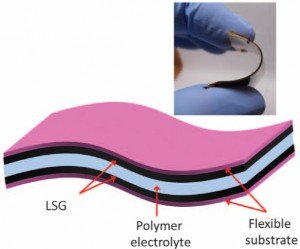Researchers create flexible laser-scribed graphene capacitors using DVD burners
Update: Check out this short video explaining this new research and showing the people behind it, and the next-gen technique unveiled in February 2013
A team of researchers from the UCLA managed to developed laser-scribed graphene (LSG) based flexible capacitors using simple DVD burners. The idea is to deposit Graphite Oxide on blank DVDs and then use a DVD burner (a light scribe drive) which uses a 780nm infrared laser. The laser reduces the Graphite Oxide to pure graphene (LSG). This LSG is placed on flexible substrates which are used as the electrodes for a super capacitor.

This is not just a gimmick process - it will be possible to scale it for commercial production, and these capacitors are fast (20 times faster than standard carbon capacitors and 3 times faster than lithium-ion batteries) and offer good density (twice than that of carbon capacitors and comparable to a high-power lithium-ion battery).
